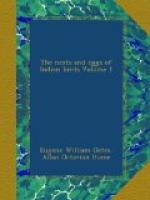Mr. Oates remarks:—“This Myna lays in Pegu in holes of trees at all heights above 20 feet. It selects a hole which is difficult of access, and I have only been able to take one nest. This was on the 13th May. This nest, a small pad of grass and leaves, contained three eggs, which were slightly incubated. They measured 0.86 by 0.7, 0.8 by 0.7, and 0.83 by 0.72.”
Major C.T. Bingham writes from Tenasserim:—“I shot a Myna as she flew out of a hole in a zimbun tree (Dillenia pentagyna). I had nearly a fortnight before seen the birds; there was a pair of them, busy taking straw and grass-roots into the hole; and so on the 18th April, when I shot the birds, I made sure of finding the full complement of eggs, but to my regret on opening the hollow, I only found one egg resting in a loose and irregularly formed nest of roots and leaves. This solitary egg is of a pale blue colour.”
The eggs vary a good deal in shape: some are broad and some are elongated ovals, but all are more or less pointed towards the small end; the shell is very fine and delicate, and rather glossy; the colour is a very delicate pale sea-green, without any markings of any kind. They vary from 0.89 to 1.0 in length, and from 0.69 to 0.72 in breadth; but the average of ten eggs is 0.93 by 0.7.
539. Sturnia nemoricola, Jerdon. The White-winged Myna.
Sturnia nemoricola, Jerd., Hume, cat. no. 688 bis.
Mr. Gates writes from Lower Pegu:—“Of S. nemoricola I have taken two sets of eggs: one set of two eggs fresh, and one of three on the point of being hatched; the former on 12th May, the latter on 6th June. In size the two clutches vary extraordinarily. The first two eggs measure .82 x .62 and .85 x .63; the second lot measure 1.01 x .7, 1.0 x .7, and 1.0 x .7.
“The eggs are very glossy, and the colour is a uniform dark greenish blue, of much the same tint as the egg of Acridotheres tristis.”
543. Ampeliceps coronatus, Blyth. The Gold-crest Myna.
Ampeliceps coronatus, Bl., Hume, Rough Draft N. & E. no. 693 sex; id. cat. no. 693 ter.
Of the nidification of this beautiful species, the Gold-crest Myna, we possess but little information. My friend Mr. Davison, who has secured many specimens of the bird, writes:—“On the 13th April, 1874, two miles from the town of Tavoy, on a low range of hills about 200 feet above the sea-level, I found a nest of the Gold-crest Grakle. The nest was about 20 feet from the ground in a hole in the branch of a large tree. It was composed entirely of coarse dry grass, mixed with dried leaves, twigs, and bits of bark, but contained no feathers, rags, or such substances as are usually found in the nests of the other Mynas. The nest contained three young ones only a day or two old.”
544. Temenuchus pagodarum (Gm.). The Black-headed Myna.
Temenuchus pagodarum (Gm.), Jerd. B. Ind. ii, p. 329; Hume, Rough Draft N. & E. no. 687.




